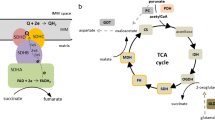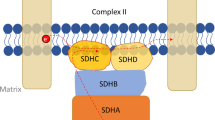Abstract
Germline mutations in genes encoding succinate dehydrogenase subunits are associated with the development of familial pheochromocytomas and paragangliomas [hereditary paraganglioma/pheochromocytoma syndrome (HPPS)]. In particular, a mutation in succinate dehydrogenase subunit B (SDHB) is highly associated with abdominal paraganglioma and subsequent distant metastasis (malignant paraganglioma), indicating the importance of SDHB genetic testing. The discovery of HPPS suggests an association among genetic mitochondrial defects, tumor development, and catecholamine oversecretion. To investigate this association, we transfected pheochromocytoma cells (PC12) with SDHB-specific siRNA. SDHB silencing virtually abolished complex II activity, demonstrating the utility of this in vitro model for investigating the pseudo-hypoxic drive hypothesis. Lack of complex II activity resulting from RNA interference of SDHB increased tyrosine hydroxylase (TH; the rate-limiting enzyme in catecholamine biosynthesis) activity and catecholamine secretion. Reduced apoptosis was observed accompanied by Bcl-2 accumulation in PC12 cells, consistent with the phenotypes of paragangliomas with SDHB mutations. In addition, SDHB silencing increased reactive oxygen species (ROS) production and nuclear HIF1α stabilization under normoxic conditions. Furthermore, phenotypes induced by complex II activity knockdown were abolished by pretreatment with N-acetyl cysteine (an ROS scavenger) and by prior HIF1α knockdown, indicating an ROS- and HIF1α-dependent mechanism. Our results indicate that increased ROS may act as signal transduction messengers that induce HIF1α stabilization and may be necessary for the pseudo-hypoxic states observed in our experimental model. To our knowledge, this is the first study demonstrating that pseudo-hypoxic states resulting from SDHB knockdown are associated with increased TH activity and catecholamine oversecretion.






Similar content being viewed by others
References
Astuti D, Latif F, Dallol A et al (2001) Gene mutations in the succinate dehydrogenase subunit SDHB cause susceptibility to familial pheochromocytoma and to familial paraganglioma. Am J Hum Genet 69:49–54
Baysal BE, Ferrell RE, Willett-Brozick JE et al (2000) Mutations in SDHD, a mitochondrial complex II gene, in hereditary paraganglioma. Science 287:848–851
Burnichon N, Briere JJ et al (2010) SDHA is a tumor suppressor gene causing paraganglioma. Hum Mol Genet 19:3011–3020
Dahia PL, Ross KN, Wright ME et al (2005) A HIF1alpha regulatory loop links hypoxia and mitochondrial signals in pheochromocytomas. PLoS Genet 1:72–80
Gimenez-Roqueplo AP, Favier J, Rustin P et al (2001) The R22X mutation of the SDHD gene in hereditary paraganglioma abolishes the enzymatic activity of complex II in the mitochondrial respiratory chain and activates the hypoxia pathway. Am J Hum Genet 69:1186–1197
Gimenez-Roqueplo AP, Favier J, Rustin P et al (2003) Mutations in the SDHB gene are associated with extra-adrenal and/or malignant phaeochromocytomas. Cancer Res 63:5615–5621
Gimenez-Roqueplo AP, Favier J, Rustin P et al (2002) Functional consequences of a SDHB gene mutation in an apparently sporadic pheochromocytoma. J Clin Endocrinol Metab 87:4771–4774
Hao HX, Khalimonchuk O, Schraders M et al (2009) SDH5, a gene required for flavination of succinate dehydrogenase, is mutated in paraganglioma. Science 325:1139–1142
Niemann S, Muller U (2000) Mutations in SDHC cause autosomal dominant paraganglioma, type 3. Nat Genet 26:268–270
Pollard PJ, El-Bahrawy M, Poulsom R et al (2006) Expression of HIF-1alpha, HIF-2alpha (EPAS1), and their target genes in paraganglioma and pheochromocytoma with VHL and SDH mutations. J Clin Endocrinol Metab 91:4593–4598
Cervera AM, Apostolova N, Crespo FL, Mata M, McCreath KJ (2008) Cells silenced for SDHB expression display characteristic features of the tumor phenotype. Cancer Res 68:4058–4067
Favier J et al (2009) The Warburg effect is genetically determined in inherited pheochromocytomas. PLoS ONE 4:e7094
Guzy RD, Sharma B, Bell E, Chandel NS, Schumacker PT (2008) Loss of the SdhB, but Not the SdhA, subunit of complex II triggers reactive oxygen species-dependent hypoxia-inducible factor activation and tumorigenesis. Mol Cell Biol 28:718–731
Kaelin WG Jr (2009) SDH5 mutations and familial paraganglioma: somewhere Warburg is smiling. Cancer Cell 16:180–182
Kaelin WG Jr, Ratcliffe PJ (2008) Oxygen sensing by metazoans: the central role of the HIF hydroxylase pathway. Mol Cell 30:393–402
López-Jiménez E (2010) Research resource: transcriptional profiling reveals different pseudohypoxic signatures in SDHB and VHL-related pheochromocytomas. Mol Endocrinol 24:2382–2391
Selak MA, Armour SM, MacKenzie ED et al (2005) Succinate links TCA cycle dysfunction to oncogenesis by inhibiting HIF-alpha prolyl hydroxylase. Cancer Cell 7:77–85
Mansfield KD, Guzy RD, Pan Y et al (2005) Mitochondrial dysfunction resulting from loss of cytochrome c impairs cellular oxygen sensing and hypoxic HIF-alpha activation. Cell Metab 1:393–399
Pan Y, Mansfield KD, Bertozzi CC et al (2007) Multiple factors affecting cellular redox status and energy metabolism modulate hypoxia-inducible factor prolyl hydroxylase activity in vivo and in vitro. Mol Cell Biol 27:912–925
Haycock JW (1990) Phosphorylation of tyrosine hydroxylase in situ at serine 8, 19, 31, and 40. J Biol Chem 265:11682–11691
Haycock JW, Wakade AR (1992) Activation and multiple-site phosphorylation of tyrosine hydroxylase in perfused rat adrenal glands. J Neurochem 58:57–64
Hwang O, Kim ML, Lee JD (1994) Differential induction of gene expression of catecholamine biosynthetic enzymes and preferential increase in norepinephrine by forskolin. Biochem Pharmacol 48:1927–1934
Czyzyk-Krzeska MF, Bayliss DA, Lawson EE, Millhorn DE (1992) Regulation of tyrosine hydroxylase gene expression in the rat carotid body by hypoxia. J Neurochem 58:1538–1546
Hui AS, Striet JB, Gudelsky G et al (2003) Regulation of catecholamines by sustained and intermittent hypoxia in neuroendocrine cells and sympathetic neurons. Hypertension 42:1130–1136
Pepin JL et al (1996) Effects of long-term hypoxia on tyrosine hydroxylase protein content in catecholaminergic rat brainstem areas: a quantitative autoradiographic study. Brain Res 733:1–8
Soulier V, Dalmaz Y, Cottet-Emard JM, Kitahama K, Pequignot JM (1995) Delayed increase of tyrosine hydroxylation in the rat A2 medullary neurons upon long-term hypoxia. Brain Res 674:188–195
Aita Y, Ishii KA, Saito Y et al (2012) Sunitinib inhibits catecholamine synthesis and secretion in pheochromocytoma tumor cells by blocking VEGF receptor 2 via PLC-gamma-related pathways. Am J Physiol Endocrinol Metab 303:E1006–E1014
Saito Y, Tanaka Y, Aita Y et al (2012) Sunitinib induces apoptosis in pheochromocytoma tumor cells by inhibiting VEGFR2/Akt/mTOR/S6K1 pathways through modulation of Bcl-2 and BAD. Am J Physiol Endocrinol Metab 302:E615–E625
Zeng LH, Okamura K, Tanaka H, Miki N, Kuo CH (2005) Concomitant translocation of Puralpha with its binding proteins (PurBPs) from nuclei to cytoplasm during neuronal development. Neurosci Res 51:105–109
Sudarshan S, Sourbier C, Kong HS et al (2009) Fumarate hydratase deficiency in renal cancer induces glycolytic addiction and hypoxia-inducible transcription factor 1alpha stabilization by glucose-dependent generation of reactive oxygen species. Mol Cell Biol 29:4080–4090
Brunelle JK, Bell EL, Quesada NM et al (2005) Oxygen sensing requires mitochondrial ROS but not oxidative phosphorylation. Cell Metab 1:409–414
Chen N, Chen X, Huang R et al (2009) BCL-xL is a target gene regulated by hypoxia-inducible factor-1{alpha}. J Biol Chem 284:10004–10012
Piret JP, Minet E, Cosse JP et al (2005) Hypoxia-inducible factor-1-dependent overexpression of myeloid cell factor-1 protects hypoxic cells against tert-butyl hydroperoxide-induced apoptosis. J Biol Chem 280:9336–9344
Peng XH, Karna P, Cao Z, Jiang BH, Zhou M, Yang L (2006) Cross-talk between epidermal growth factor receptor and hypoxia-inducible factor-1alpha signal pathways increases resistance to apoptosis by up-regulating survivin gene expression. J Biol Chem 281:25903–25914
de Krijger RR, van der Harst E, van der Ham F et al (1999) Prognostic value of p53, bcl-2, and c-erbB-2 protein expression in phaeochromocytomas. J Pathol 188:51–55
Park SY, Billiar TR, Seol DW (2002) Hypoxia inhibition of apoptosis induced by tumor necrosis factor-related apoptosis-inducing ligand (TRAIL). Biochem Biophys Res Commun 291:150–153
Lee S, Nakamura E, Yang H (2005) Neuronal apoptosis linked to EglN3 prolyl hydroxylase and familial pheochromocytoma genes: developmental culling and cancer. Cancer Cell 8:155–167
Clifford SC, Cockman ME, Smallwood AC et al (2001) Contrasting effects on HIF-1alpha regulation by disease-causing pVHL mutations correlate with patterns of tumourigenesis in von Hippel–Lindau disease. Hum Mol Genet 10:1029–1038
Bauer AL, Paulding WR, Striet JB, Schnell PO, Czyzyk-Krzeska MF (2002) Endogenous von Hippel–Lindau tumor suppressor protein regulates catecholaminergic phenotype in PC12 cells. Cancer Res 62:1682–1687
Gozal E, Shah ZA, Pequignot JM et al (2005) Tyrosine hydroxylase expression and activity in the rat brain: differential regulation after long-term intermittent or sustained hypoxia. J Appl Physiol 99:642–649
Raghuraman G, Rai V, Peng YJ, Prabhakar NR, Kumar GK (2009) Pattern-specific sustained activation of tyrosine hydroxylase by intermittent hypoxia: role of reactive oxygen species-dependent downregulation of protein phosphatase 2A and upregulation of protein kinases. Antioxid Redox Signal 11:1777–17789
Schnell PO, Ignacak ML, Bauer AL, Striet JB, Paulding WR, Czyzyk-Krzeska MF (2003) Regulation of tyrosine hydroxylase promoter activity by the von Hippel–Lindau tumor suppressor protein and hypoxia-inducible transcription factors. J Neurochem 85:483–491
Koivunen P, Lee S, Duncan CG et al (2012) Transformation by the (R)-enantiomer of 2-hydroxyglutarate linked to EGLN activation. Nature 483:484–488
Acknowledgments
This study was supported in part by a Grant-in-Aid for Scientific Research from the Ministry of Education, Culture, Sports, Science and Technology of Japan, No. 21591168 (to K.T.) and No. 23591889 (to H.H).
Author information
Authors and Affiliations
Corresponding author
Ethics declarations
Conflict of interest
The authors declare no conflicts of interest, financial or otherwise.
Electronic supplementary material
Below is the link to the electronic supplementary material.
Rights and permissions
About this article
Cite this article
Saito, Y., Ishii, Ka., Aita, Y. et al. Loss of SDHB Elevates Catecholamine Synthesis and Secretion Depending on ROS Production and HIF Stabilization. Neurochem Res 41, 696–706 (2016). https://doi.org/10.1007/s11064-015-1738-3
Received:
Accepted:
Published:
Issue Date:
DOI: https://doi.org/10.1007/s11064-015-1738-3




